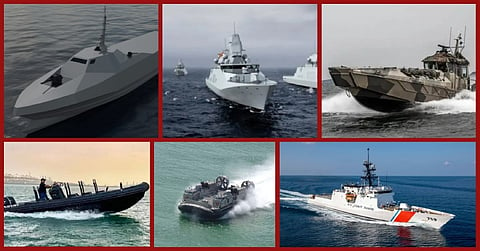

Deliveries include inflatable boats for the Albanian military and an air-cushion landing craft for the US Navy. The US Coast Guard's newest large cutter completes builder's sea trials while construction is underway on new manned and unmanned surface vessels slated for operators in Europe. Finally, the Finnish defence ministry has approved the purchase of new naval support landing craft.
Albanian defence ministry acquires 13 inflatable boats from UAE builder
UAE builder Asis Boats recently delivered 13 inflatable boats to the Ministry of Defence of Albania for use by the Albanian Naval Force.
The delivered RIBs include two 9.5-metre rigid inflatable boats (RIBs), four 7.5-mere RIBs, and seven 4.7-metre fully inflatable boats. The 9.5-metre RIBs are each powered by two Mercury 186kW outboards while the 7.5-metre RIBs each have twin Mercury 111kW outboards.
The RIBs utilise Asis Boats' proprietary hull design that minimises water spray, ensuring more comfortable sailing.
New ship-to-shore connector landing craft delivered to US Navy
The US Navy has taken delivery of its newest Ship to Shore Connector (SSC) air-cushion landing craft, LCAC 107.
Built by the Textron Marine and Land Systems division of Textron Systems Corporation. the vessel has an LOA of 92 feet (28 metres), a beam of 48 feet (14.6 metres), a height of 26 feet (7.92 metres), and a four-strong crew consisting of a pilot, a co-pilot, a loadmaster, and a deck engineer. It is capable of making ship-to-shore transits over a distance of 25 nautical miles, ensuring the navy's larger ships can remain in the relative safety of offshore waters when amphibious landings of troops, vehicles, and equipment are conducted in denied areas.
The craft's open deck has a total area of 1,608 square feet (149 square metres) and can accommodate a maximum of 74 tons (67 tonnes) of assorted loads such as main battle tanks and other armoured vehicles, support vehicles, and heavy equipment. Separate from the cargo deck is an enclosed personnel transport module that can house 145 combat-equipped troops or 108 casualty victims.
US Coast Guard cutter Calhoun completes builder's sea trials
Huntington Ingalls Industries' (HII) Ingalls Shipbuilding division has successfully completed builder's sea trials for the US Coast Guard's newest Legend-class National Security Cutter, the future USCGC Calhoun.
The ship successfully tested propulsion and auxiliary equipment as well as various ship systems.
The future Calhoun honours Charles L. Calhoun, the first master chief petty officer of the US Coast Guard. As with other Legend-class cutters, it will be capable of embarking and supporting a wide range of coast guard, US Navy, and NATO manned and unmanned aircraft.
Missions will include drug interdiction, anti-illegal fishing patrols, disaster relief, and defence support operations.
Dutch builder selected for construction of anti-submarine frigates
The Dutch Ministry of Defence, the Damen Shipyards Group, and technology company Thales have entered into an agreement for the design, construction, and delivery of four anti-submarine warfare (ASW) frigates for operation by the Royal Netherlands and Belgian Navies.
The Netherlands and Belgium will each receive two frigates. In Dutch service, the vessels will replace the ageing Karel Doorman-class frigates that were originally designed in the late 1980s.
The frigates will have hybrid diesel-electric propulsion systems and will be designed to sail as quietly as possible to avoid detection by hostile submarines as much as possible.
Each frigate will have a length of 145 metres, a beam of 18 metres, a draught of 5.5 metres, a displacement of 6,400 tonnes, and space for 117 crewmembers as well as unmanned craft.
Armament will include a 76mm naval gun, torpedoes, and surface-to-air and surface-to-surface missiles. Damen said the design can also accommodate other weapons such as high-energy lasers.
Consortium to build autonomous warships for European customers
A consortium led by Estonian builder Baltic Workboats has been awarded €95 million (US$103 million) in funding to develop a new range of autonomous warships for European naval operators.
The EUROGUARD initiative aims to develop a modular and semi-autonomous surface vessel platform with a remote control system that could be used across Europe. The design will be adaptable for various missions and will enable application in different naval command and support roles.
The €95 million includes €65 million (US$70 million) from the European Defence Fund and €30 million (US$32.6 million) from the participating countries and companies involved in the project.
The prototype vessel will undergo sea trials in Estonian waters in collaboration with the Estonian Navy.
Finnish Defence Forces to get additional landing craft
Finland's Minister of Defence Antti Häkkänen has authorised the Finnish Defence Forces to place an order for 17 Jurmo-class landing craft to be built by local shipyard Marine Alutech.
The overall value of the procurement is estimated at €25.5 million (US$27.7 million) without value added tax. The contract also covers the acquisition of spare parts for the vessels.
The newer landing craft will have operational lives that will last up to the end of the 2030s.
